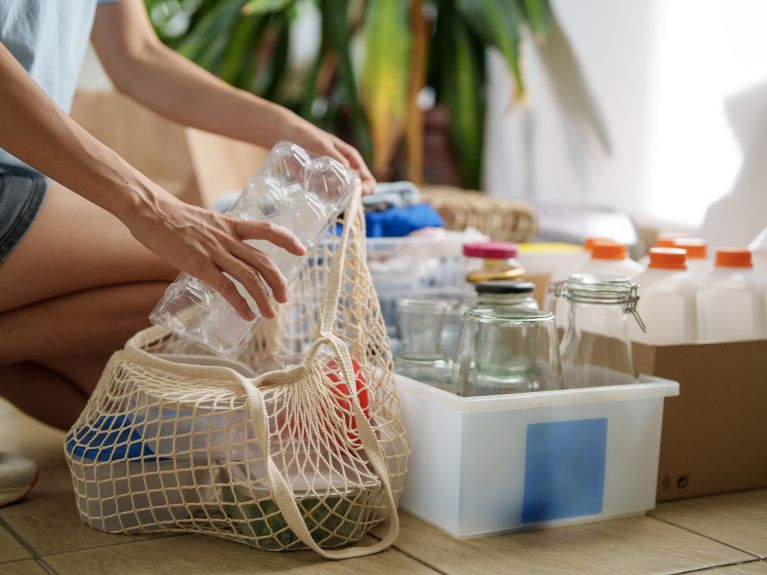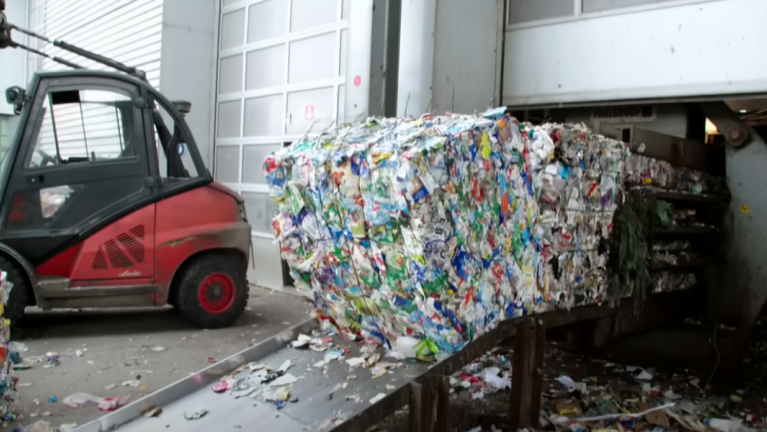How does waste separation work in Germany?
The land of colourful bins: Germans sort their waste carefully – and turn it into new products. A short guide.

Consumer society comes at a price: mountains of waste. In 2023, Germany generated over 380 million tonnes of waste – around 4.5 tonnes per person. The good news is that the waste mountain is shrinking, as more and more waste is being reused.
More than half of the waste in Germany is construction and demolition waste, which is reused in road building or as recycled concrete, or incinerated in power and cement plants. The situation is trickier with the waste people generate in their day-to-day lives.
How much household waste does one person in Germany produce?
In 2023 alone, Germany produced 48.9 million tonnes of household and municipal waste. On average, each person in Germany generates 1.7 kilograms of paper, glass, plastic, organic or electronic waste per day. That’s less than in the US – but more than in many other EU countries.
Because of the many different types of waste, disposal is complicated. People in Germany have been systematically sorting waste for over 40 years to enable recycling and reuse. Today, 70 per cent of all waste is recycled – a top figure internationally that the EU wants all its members to achieve within ten years. Researchers estimate that recycling in Germany saves approximately the level of climate-damaging emissions that is emitted by a city such as Bonn.
What is the “Green Dot”?
Since 1991, a dual system has operated in parallel with municipal waste collection. Anyone who puts plastic packaging on the market has to pay a licensing fee and earns the right to print a Green Dot on the packaging. This indicates that the products are recyclable. Disposal companies collect and process the packaging. The exact rules are set out in the Packaging Act.
Why are there so many different bins?
This recycling-focused system depends on people separating their household waste. Lightweight packaging with the Green Dot – made of plastic, metal or composites – goes in the yellow bin or yellow sack. Organic kitchen and garden waste goes in the organic bin. Non-recyclable residual waste such as nappies, cigarette butts or vacuum cleaner bags goes in the grey or black bin and is usually incinerated.
How does recycling work for paper and glass?
That’s by no means the whole story – there are more bins and containers. Used paper, cardboard and cartons go in the paper bin – blue or green. Since Germans have been collecting paper for so long, around 80 per cent of all paper is already made of paper that has been recycled.
Glass bottles are sorted by colour and go into municipal containers. And the system works: 60 per cent of glass bottles and almost 100 per cent of green ones are made from recycled glass.
Why is there a deposit on bottles and cans?
Alongside the dual system, a well-developed deposit system makes it easier to reuse raw materials. In Germany, reusable glass or robust PET bottles are subject to a deposit of 8 to 15 cents – which is refunded on return. The result: glass bottles can be reused up to 50 times, PET bottles up to 20 times. Since 2003, a 25-cent deposit also applies to single-use bottles – so most people return plastic or aluminium bottles and cans to supermarkets for recycling. Since 2023, restaurants and cafés have also been required to offer reusable packaging such as coffee cups or takeaway containers.
Dieses YouTube-Video kann in einem neuen Tab abgespielt werden
YouTube öffnenThird party content
We use YouTube to embed content that may collect data about your activity. Please review the details and accept the service to see this content.
Open consent formWhat happens to old clothes and hazardous waste?
Old clothes are also collected in containers and either reused or recycled. Hazardous waste is sorted, too. Batteries are returned to supermarkets, while electronic devices are handed back to retailers or taken to recycling centres. Many centres now even operate their own repair workshops where old appliances are fixed.
Who takes care of the waste?
Waste processing is not just a part of day-to-day life in Germany – it’s also a major economic sector. Around 1,700 waste and recycling companies employ some 300,000 people using state-of-the-art technology. High-tech facilities can sort up to 14 tonnes of waste per hour. High-precisions sensors identify different materials in milliseconds with up to 98 per cent accuracy. Using smart solutions, the industry is helping to reduce the mountains of waste.



